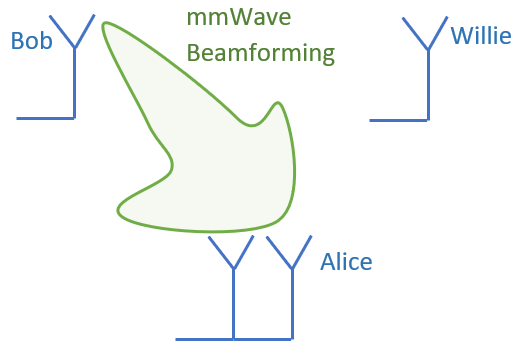mmWave Beamforming provides physical layer security to help achieve covert communications. Alice wishes to transmit to Bob, but there is warden Willie within listening distance on the wireless channel. The covert probability is the likelihood that Willie incorrectly detects there is a communication between Alice and Bob. This probability is dependent on the received signal power at Willie’s receiver from Alice, Sw, the signal power of interferers at Willie, and the noise power. Therefore, minimizing Sw increases the covert probability.
mmWave communications has been of interest for 5G and 6G researchers because of the ultra-wide bandwidth. The large number of operating frequencies provides potential for channel/user capacity. This alone makes Willie’s detection problem more difficult by having to search a large frequency space. Multi-antenna systems with beamforming increases the covert probability. The utilization of beamforming allows one to create a radiation pattern, which focuses the majority of the signal energy in the direction of the desired target. The width of the beam is dependent on the spacing, frequency (wavelength) and the number of antenna elements. The antenna spacing must be less than half of the wavelength of the frequency of interest. Given the small millimeter wavelength, a large number of antennas can be placed in a small space. As the number of antennas increases, the beam width narrows and Sw decreases. Also, if the direction of Willie is known, a null in the beam pattern can be placed in the direction of Willie.
Some potential challenges of mmWave communications include doppler shift and the requirement of line-of-sight between Alice and Bob. These channel characteristics must be taken into account for the covert communication system design.
